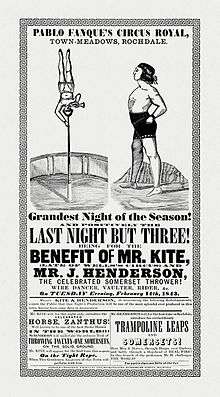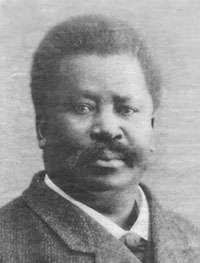Being for the Benefit of Mr. Kite!
| "Being for the Benefit of Mr. Kite!" | |||||||
|---|---|---|---|---|---|---|---|
| Song by the Beatles from the album Sgt. Pepper's Lonely Hearts Club Band | |||||||
| Released | 1 June 1967 | ||||||
| Recorded | 17 and 20 February and 28, 29, 31 March 1967 | ||||||
| Genre | |||||||
| Length | 2:37 | ||||||
| Label | Parlophone | ||||||
| Writer(s) | Lennon–McCartney | ||||||
| Producer(s) | George Martin | ||||||
| |||||||
"Being for the Benefit of Mr. Kite!" is a song by the English rock band the Beatles, from their 1967 album Sgt. Pepper's Lonely Hearts Club Band. It was primarily written and composed by John Lennon, although Paul McCartney claims that he also contributed to it.[2][3] The song is credited to Lennon–McCartney.
Inspiration

The inspiration to write the song was a 19th-century circus poster for Pablo Fanque's Circus Royal appearance at Rochdale, that Lennon purchased in an antique shop on 31 January 1967, while filming the promotional videos for "Penny Lane" and "Strawberry Fields Forever" in Sevenoaks, Kent.[4] Lennon claimed years later to still have the poster in his home.[5] "Everything from the song is from that poster," he explained, "except the horse wasn't called Henry."[6] (The poster identifies the horse as "Zanthus.")
The song is credited to Lennon–McCartney, but Lennon claimed to have written it entirely himself.[5] McCartney disagrees;[2] in a 2013 Rolling Stone interview states: "I read, occasionally, people say, 'Oh, John wrote that one.' I say, 'Wait a minute, what was that afternoon I spent with him, then, looking at this poster?' He happened to have a poster in his living room at home. I was out at his house, and we just got this idea, because the poster said 'Being for the Benefit of Mr. Kite' – and then we put in, you know, 'there will be a show tonight,' and then it was like, 'of course,'...The song just wrote itself. So, yeah, I was happy to kind of reclaim it as partially mine.'"[3]
Mr. Kite is believed to be William Kite, who worked for Pablo Fanque from 1843 to 1845.

The full text of the original Pablo Fanque's Circus Royal poster is:
- PABLO FANQUE'S CIRCUS ROYAL,
- TOWN-MEADOWS, ROCHDALE.
- Grandest Night of the Season!
- AND POSITIVELY THE
- LAST NIGHT BUT THREE!
- BEING FOR THE
- BENEFIT OF MR. KITE,
- (LATE OF WELLS'S CIRCUS) AND
- MR. J. HENDERSON,
- THE CELEBRATED SOMERSET THROWER!
- WIRE DANCER, VAULTER, RIDER, &c.
- On TUESDAY Evening, February 14, 1843.
- Mssrs. KITE and HENDERSON, in announcing the following Entertainments, assure the Public that this Night's Production will be one of the most splendid ever produced in this town, having been some days in preparation.
- Mr. KITE will, for this night only, introduce the
- CELEBRATED
- HORSE, ZANTHUS!
- Well known to be one of the
- best Broke Horses
- IN THE WORLD!!!
- Mr. HENDERSON will undertake the arduous Task of
- THROWING TWENTY-ONE SOMERSETS,
- ON THE SOLID GROUND.
- Mr. KITE will appear, for the first time this season,
- On the Tight Rope,
- When Two Gentlemen Amateurs of this Town will
- perform with him.
- Mr. HENDERSON will, for the first time in Rochdale,
- introduce his extraordinary
- TRAMPOLINE LEAPS
- AND
- SOMERSETS!
- Over Men & Horses, through Hoops, over Garters,
- and lastly through a
- Hogshead of REAL FIRE!
- In this branch of the profession Mr. H challenges
- THE WORLD!
- For particulars see Bills of the day.
- JONES & CROSSKILL, PRINTERS AND BOOKSELLERS, YORKSHIRE STREET, ROCHDALE.
"Mr. J. Henderson" was John Henderson, a wire-walker, equestrian, trampoline artist, and clown. While the poster made no mention of "Hendersons" plural, as Lennon sings, John Henderson did perform with his wife Agnes, the daughter of circus owner Henry Hengler. The Hendersons performed throughout Europe and Russia during the 1840s and 1850s.[7] A hogshead is a large wooden cask.
Recording
One of the most musically complex songs on Sgt. Pepper, it was recorded by the Beatles on 17 February 1967 with overdubs on 20 February (organ sound effects), 28 March (harmonica, organ, guitar), 29 March (more organ sound effects), and 31 March.[8] Lennon wanted the track to have a "carnival atmosphere", and told producer George Martin that he wanted "to smell the sawdust on the floor." In the middle eight bars, multiple recordings of fairground organs and calliope music were spliced together to attempt to produce this request. In a 1968 interview, Martin recalled that he achieved "this by playing the Hammond organ myself and speeding it up."[9]In addition to the Hammond organ, a 19th century steam organ was found for hire to enhance the carnival atmosphere effect.[10] After a great deal of unsuccessful experimentation, Martin instructed recording engineer Geoff Emerick to chop the tape into pieces with scissors, throw them up in the air, and re-assemble them at random.[11]
Before the start of the first take, Lennon sings the words "For the benefit of Mr. Kite!" in a joke accent, then Emerick announces, "For the Benefit of Mr. Kite! This is take 1." Lennon immediately responds, "Being for the Benefit of Mr. Kite!", reinforcing his title preference from a phrase lifted intact from the original Pablo Fanque poster. The exchange is recorded in The Beatles Recording Sessions (slightly misquoted)[4] and audible on track 8 of disc 2 of Anthology 2. The original recording can also be heard during the loading screen for the song if it is downloaded in the video game The Beatles: Rock Band.
Although Lennon once said of the song that he "wasn't proud of that" and "I was just going through the motions,"[12] in 1980 he described it as "pure, like a painting, a pure watercolour."[6]
It was one of three songs from the Sgt. Pepper album that was banned from playing on the BBC, supposedly because the phrase "Henry the Horse" combined two words that were individually known as slang for heroin. Lennon denied that the song had anything to do with heroin.[5][6]
Personnel
- John Lennon - double-tracked lead vocals and harmony vocals, Hammond organ, tape loops and harmonica
- Paul McCartney - bass guitar
- George Harrison - backwards lead guitar and harmonica
- Ringo Starr - drums, tambourine, shaker and harmonica
- George Martin - piano, harmonium, Lowrey organ, glockenspiel, tape loops and Hammond organ[9]
- Mal Evans - bass harmonica
- Neil Aspinall - harmonica
- Geoff Emerick - tape loops
Live performances
Paul McCartney performed the song live for the first time by any Beatle on 4 May 2013 at the Estádio Mineirão, Belo Horizonte, Brazil and throughout his 2013–2015 Out There tour. Additionally, McCartney performed the song live on the Colbert Report on 12 June 2013 as well as during his One on One tour in 2016.
Covers and influence
- The Bee Gees, with Maurice Gibb on lead vocals, and George Burns performed the song in the 1978 film Sgt. Pepper's Lonely Hearts Club Band. Burns plays the Mr. Kite character as the mayor of the band's home town and the song is played by the band as a playful announcement of their return to the town for Mr. Kite's benefit.
- Električni Orgazam recorded a version on their 1983 cover album Les Chansones Populaires.
- Billy Connolly recorded a mostly spoken-word recording of the song for the George Martin compilation In My Life.
- In the film Across the Universe, Eddie Izzard appears in a cameo as Mr. Kite, a circus ringmaster and does a cover of the song in a spoken form, adlibbing in between verses.
- In 2009, Cheap Trick released Sgt. Pepper Live, which includes the song.
- The Residents performed a cover of the song at a 40th Anniversary celebration of Sgt. Pepper with the London Sinfonietta.
- Les Fradkin has an instrumental cover in his 2007 release Pepper Front to Back.
- Mister Kite take their name from the song title.
- Easy Star All-Stars covered the song on the album Easy Star's Lonely Hearts Dub Band.
- Eric McFadden covered this song on his Devil Moon CD (2005).
- Frank Sidebottom covered this song on the Sgt. Pepper's Lonely Hearts Club Band 21st anniversary charity album Sgt. Pepper Knew My Father.
- Al Di Meola covered the song on his 2013 CD All Your Life.
Notes
- ↑ Ronald P. Grelsamer (September 1, 2010). Into the Sky with Diamonds: The Beatles and the Race to the Moon in the Psychedelic '60S. AuthorHouse. p. 252. ISBN 978-1-4520-7053-7.
- 1 2 Miles 1997, pp. 318.
- 1 2 Vozick-Levinson, Simon (25 July 2013). "Q&A: Paul McCartney Looks Back on His Latest Magical Mystery Tour". Rolling Stone. Retrieved 27 July 2013.
- 1 2 Lewisohn 1988, pp. 98.
- 1 2 3 "Lennon–McCartney Songalog: Who Wrote What" (PDF). The Hit Parader Interview Magazine. Hit Parader. Winter 1977 [reprint of April 1972] (101): 38–41. Retrieved 27 February 2014.
- 1 2 3 Sheff 2000, p. 183.
- ↑ "The Hendersons Were Not There (and neither was Mr Kite)- Sheffield 1848". Chrishobbs.com. 28 March 1914. Retrieved 1 May 2011.
- ↑ Lewisohn 1988, pp. 98, 99, 105–106.
- 1 2 Gilliland 1969, show 45, track 3, 6:22.
- ↑ Emerick 2006.
- ↑ Lewisohn 1988, pp. 99.
- ↑ The Beatles 2000, pp. 243.
References
- The Beatles (2000). The Beatles Anthology. San Francisco: Chronicle Books. ISBN 0-8118-2684-8.
- Gilliland, John (1969). "Sergeant Pepper at the Summit: The very best of a very good year" (audio). Pop Chronicles. Digital.library.unt.edu.
- Lewisohn, Mark (1988). The Beatles Recording Sessions. New York: Harmony Books. ISBN 0-517-57066-1.
- Miles, Barry (1997). Paul McCartney: Many Years From Now. New York: Henry Holt and Company. ISBN 0-8050-5249-6.
- Sheff, David (2000). All We Are Saying: The Last Major Interview with John Lennon and Yoko Ono. New York: St. Martin's Press. ISBN 0-312-25464-4.
External links
- Alan W. Pollack's Notes on "Being for the Benefit of Mr. Kite!"
- Discussion of the original poster
- A short film, containing close-up shots of the original poster
- Comparisons of modern reproductions of the poster with the original
- Lyrics of this song at MetroLyrics